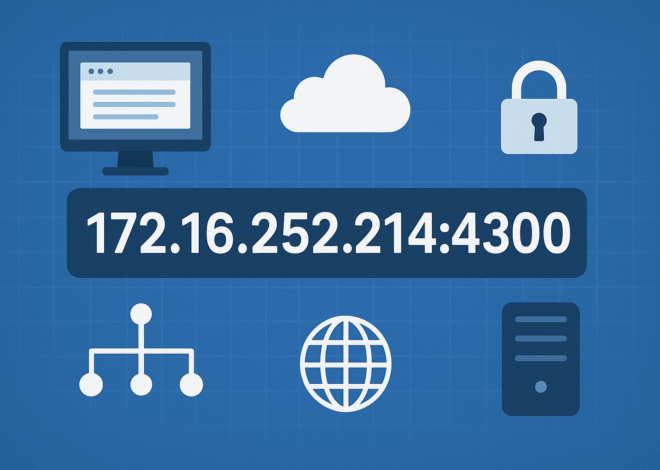
Possibilities with 203.160.175.158:14001 – Your Gateway to Enhanced Connectivity
What is 203.160.175.158:14001?
The term 203.160.175.158:14001 refers to a specific Internet Protocol (IP) address combined with a port number. An IP address serves as a unique identifier for devices on a network, ensuring that data transmitted across the internet reaches the correct destination. In this case, 203.160.175.158 is a public IP address assigned to a device that is connected to the internet, while the port number 14001 indicates a specific communication endpoint on that device.
Understanding the significance of the port number is essential. Ports act as communication channels, allowing various applications to send and receive data over the internet. The port number provides a way for the server associated with the IP address to distinguish between different services running on the same machine. Thus, port 14001 might be designated for a particular service, which could range from a web server to a secure file transfer application.
For users, recognizing the address 203.160.175.158:14001 can be critical when troubleshooting network issues or optimizing online connectivity. Various online services may require users to configure their networks to allow traffic through specific ports like 14001. This is especially relevant in home networking setups where personal firewalls or routers might block certain ports by default, causing disruptions in communication with applications utilizing that specific endpoint.
Conversely, understanding this address also aids in improving online experiences by ensuring compatibility with applications that depend on specific IP addresses and ports. Therefore, having a comprehensive grasp of what 203.160.175.158:14001 represents can be a vital aspect as individuals explore ways to optimize their connectivity and harness the full potential of the services available through this network configuration.
The Importance of 203.160.175.158:14001 in Modern Networking
The evolution of networking in modern technology has highlighted the significance of specific IP addresses, notably 203.160.175.158:14001. This particular address plays a pivotal role in various applications across multiple fields, such as cybersecurity, data transfer, and user access management. Its utility and relevance continue to proliferate as organizations and individuals seek enhanced connectivity solutions.
In cybersecurity, 203.160.175.158:14001 provides a unique conduit for establishing secure communication channels. By utilizing this IP address, organizations can implement robust security protocols to safeguard data transmissions from potential breaches. The address facilitates secure tunnels that help in maintaining the integrity and confidentiality of sensitive data, making it essential for sectors that prioritize security, such as finance and healthcare.
Moreover, 203.160.175.158:14001 is integral to efficient data transfer processes. Businesses increasingly rely on stable and swift transfer methods for large data sets. This IP address enables direct paths for data exchange, reducing latency and optimizing network performance. Its application in cloud services and remote work arrangements underscores its utility in ensuring reliable connectivity, thereby enhancing productivity and operational efficiency.
Furthermore, in the realm of user access management, 203.160.175.158:14001 plays a crucial role in controlling access to networks and services. It can be utilized for authenticating user sessions, ensuring that only authorized individuals gain entry to sensitive resources. This aspect is particularly relevant for organizations that implement stringent access controls to protect proprietary information and maintain compliance with regulatory requirements.
Real-world examples illustrate the far-reaching implications of 203.160.175.158:14001, as businesses increasingly adopt this IP address to bolster their networking infrastructures. As we navigate through an increasingly interconnected digital landscape, the importance of such IP addresses becomes more evident in promoting seamless connectivity and service accessibility for all users.

Accessing and Utilizing 203.160.175.158:14001
To effectively access and utilize the features associated with the IP address 203.160.175.158:14001, a systematic approach is essential. Begin by ensuring that your device is connected to the internet. This may involve using a wired connection or a dependable Wi-Fi network. Open your preferred web browser and enter the address in the address bar. If configured correctly, this should direct you to the login interface associated with 203.160.175.158:14001.
Login credentials will typically be required to access the interface. These credentials can often be found in the documentation provided with your device or software. If this information is missing or forgotten, consult the manufacturer’s website for guidance on resetting credentials. Once logged in, you will be presented with a user-friendly dashboard that allows you to configure various settings pertinent to 203.160.175.158:14001.
It is advisable to configure initial settings such as network preferences, security protocols, and any features that are specifically relevant to your needs. Additionally, ensure that any required software or tools are properly installed on your device. This may include network management tools or applications designed to interact with the services available through 203.160.175.158:14001.
In case you encounter connection issues, a series of troubleshooting steps can be employed. First, verify if the correct IP address is being used, ensuring that there are no typographical errors. Restarting the router or modem can often resolve connectivity problems. If issues persist, checking firewall settings may be necessary, as these can sometimes block access to specific IP addresses.
By following these guidelines, users can maximize their ability to utilize the functionalities of 203.160.175.158:14001, enhancing connectivity and ensuring a seamless experience.
Security Considerations When Using 203.160.175.158:14001
As technology advances, the importance of maintaining secure connections through IP addresses such as 203.160.175.158:14001 cannot be overstated. While this IP address provides enhanced connectivity, it is essential to address the potential security risks associated with its use. Users must be vigilant against unauthorized access, which can lead to data breaches compromising sensitive information.
Unauthorized access can occur when cybercriminals exploit vulnerabilities in the network. It is crucial for users to ensure that their devices and networks are equipped with robust security measures. One effective method for safeguarding data is the implementation of firewalls. Firewalls act as barriers between trusted internal networks and untrusted external networks, controlling incoming and outgoing traffic and mitigating potential threats.
Another valuable security practice is utilizing Virtual Private Networks (VPNs). VPNs encrypt data transmitted over the internet, providing an additional layer of security while accessing 203.160.175.158:14001. By masking the user’s IP address, VPNs also enhance privacy, making it more challenging for malicious entities to intercept data or track online activities. Regularly updating VPN software is essential to take advantage of the latest security features.
In addition to firewalls and VPNs, establishing a routine for monitoring network activity is highly recommended. Regular network audits can help detect unusual patterns or unauthorized attempts to access the system. Users should also stay informed about potential vulnerabilities within their devices and networks, promptly applying updates and patches to enhance security further.
By implementing these best practices—firewalls, VPNs, and vigilant monitoring—users can effectively navigate the potential security challenges of using 203.160.175.158:14001. Ensuring a secure environment not only protects valuable data but also promotes a more reliable user experience.


